
Cromford Canal
Encyclopedia
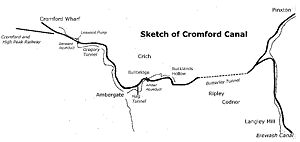
Cromford
Cromford is a village, two miles to the south of Matlock in the Derbyshire Dales district in Derbyshire, England. It is principally known for its historical connection with Richard Arkwright, and the Cromford Mill which he built here in 1771...
to the Erewash Canal
Erewash Canal
The Erewash Canal is a broad canal in Derbyshire, England. It runs just under and has 14 locks. The first lock at Langley Bridge is actually part of the Cromford Canal.-Origins:...
in Derbyshire
Derbyshire
Derbyshire is a county in the East Midlands of England. A substantial portion of the Peak District National Park lies within Derbyshire. The northern part of Derbyshire overlaps with the Pennines, a famous chain of hills and mountains. The county contains within its boundary of approx...
, England
England
England is a country that is part of the United Kingdom. It shares land borders with Scotland to the north and Wales to the west; the Irish Sea is to the north west, the Celtic Sea to the south west, with the North Sea to the east and the English Channel to the south separating it from continental...
with a branch to Pinxton
Pinxton
Pinxton is a village on the eastern boundary of Derbyshire in the Bolsover district, England.In Anglo-Saxon times it was a small agricultural community, thought to have been recorded in the Domesday Book as "Esnotrewic." It is also thought that it was known as "Snodeswic," given by Wulfric Spott to...
. Built by William Jessop
William Jessop
William Jessop was an English civil engineer, best known for his work on canals, harbours and early railways in the late 18th and early 19th centuries.-Early life:...
with the assistance of Benjamin Outram
Benjamin Outram
Benjamin Outram was an English civil engineer, surveyor and industrialist. He was a pioneer in the building of canals and tramways.-Personal life:...
, its alignment included four tunnel
Tunnel
A tunnel is an underground passageway, completely enclosed except for openings for egress, commonly at each end.A tunnel may be for foot or vehicular road traffic, for rail traffic, or for a canal. Some tunnels are aqueducts to supply water for consumption or for hydroelectric stations or are sewers...
s and 14 locks.
From Cromford it ran south following the 300 feet (91.4 m) contour line along the east side of the valley of the Derwent
River Derwent, Derbyshire
The Derwent is a river in the county of Derbyshire, England. It is 66 miles long and is a tributary of the River Trent which it joins south of Derby. For half its course, the river flows through the Peak District....
to Ambergate
Ambergate
Ambergate is a village in Derbyshire, England, where the River Amber joins the River Derwent.Until the early nineteenth century it was known as Toadmoor, with no more than a few artisans' cottages. The southerly half of the village was still shown as such on the Ordnance Survey's maps.It is about ...
, where it turned eastwards along the Amber valley
River Amber
The River Amber is a river in Derbyshire, England which rises close to the village of Ashover, near Clay Cross, and flows southwards through Ogston Reservoir to Pentrich then westwards to join the River Derwent at Ambergate...
. It turned sharply to cross the valley, crossing the river and the Ambergate to Nottingham
Nottingham
Nottingham is a city and unitary authority in the East Midlands of England. It is located in the ceremonial county of Nottinghamshire and represents one of eight members of the English Core Cities Group...
road, by means of an aqueduct at Bullbridge
Bullbridge
Bullbridge is a small village in Derbyshire. The Bull bridge accident happened here in 1860.-The village:Bullbridge has a population of approx...
, before turning towards Ripley
Ripley, Derbyshire
Ripley is a town in the Amber Valley area of Derbyshire in England.- Earliest history :Not much information is available as to when Ripley was founded, but it existed at the time of the Domesday Book, when it was held by a man called Levenot....
. From there the Butterley Tunnel
Butterley Tunnel
Butterley Tunnel is a one and three quarter mile long canal tunnel on the Cromford Canal below Ripley, in Derbyshire, England, opened to traffic in 1794.-Origins:...
took it through to the Erewash Valley
Erewash Valley
The Erewash Valley is the valley of the River Erewash on the border of Derbyshire and Nottinghamshire as far as the River Trent. It runs along the boundary of the southern end of the Derbyshire hills and the more rolling Nottinghamshire country...
.
From the tunnel it continued to Pye Hill, near Ironville
Ironville
Ironville in Derbyshire, England, was built about 1830 by the Butterley Company as a "model village" to house its workers. It is situated between Riddings and Codnor Park....
, the junction for the branch to Pinxton, and then descended through fourteen locks to meet the Erewash Canal at Langley Mill
Langley Mill
Langley Mill is a small town in the Amber Valley district of Derbyshire, England. It is on the border of Nottinghamshire, and runs into the towns of Aldercar and Heanor . Across the River Erewash is the Nottinghamshire town of Eastwood. It is part of the Aldercar and Langley Mill parish....
. The Pinxton Branch became important as a route for Nottinghamshire
Nottinghamshire
Nottinghamshire is a county in the East Midlands of England, bordering South Yorkshire to the north-west, Lincolnshire to the east, Leicestershire to the south, and Derbyshire to the west...
coal, via the Erewash, to the River Trent
River Trent
The River Trent is one of the major rivers of England. Its source is in Staffordshire on the southern edge of Biddulph Moor. It flows through the Midlands until it joins the River Ouse at Trent Falls to form the Humber Estuary, which empties into the North Sea below Hull and Immingham.The Trent...
and Leicester
Leicester
Leicester is a city and unitary authority in the East Midlands of England, and the county town of Leicestershire. The city lies on the River Soar and at the edge of the National Forest...
and was a terminus of the Mansfield and Pinxton Railway
Mansfield and Pinxton Railway
The Mansfield and Pinxton Railway was an early horse-drawn railway company in the United Kingdom, constructed in 1819 to transport coal between Mansfield and the head of the Pinxton branch of the Cromford Canal and thence by the Erewash Valley and the Trent to Leicester...
.
A 6 miles (9.7 km) long section of the Cromford canal between Cromford
Cromford
Cromford is a village, two miles to the south of Matlock in the Derbyshire Dales district in Derbyshire, England. It is principally known for its historical connection with Richard Arkwright, and the Cromford Mill which he built here in 1771...
and Ambergate
Ambergate
Ambergate is a village in Derbyshire, England, where the River Amber joins the River Derwent.Until the early nineteenth century it was known as Toadmoor, with no more than a few artisans' cottages. The southerly half of the village was still shown as such on the Ordnance Survey's maps.It is about ...
is listed as a Biological Site of Special Scientific Interest
Site of Special Scientific Interest
A Site of Special Scientific Interest is a conservation designation denoting a protected area in the United Kingdom. SSSIs are the basic building block of site-based nature conservation legislation and most other legal nature/geological conservation designations in Great Britain are based upon...
(SSSI).
In addition to purely canal traffic, there was a lively freight interchange with the Cromford and High Peak Railway
Cromford and High Peak Railway
The Cromford and High Peak Railway in Derbyshire, England, was completed in 1831, to carry minerals and goods between the Cromford Canal wharf at High Peak Junction and the Peak Forest Canal at Whaley Bridge -Origins:...
, which traversed the plateau of the Peak District from Whaley Bridge in the north west, and which descended to the canal at High Peak Junction
High Peak Junction
High Peak Junction, near Cromford, Derbyshire, England, is the name now used to describe the site where the former Cromford and High Peak Railway , whose workshops were located here, meets the Cromford Canal...
by means of an inclined plane.
Origins
At the end of the eighteenth century an extension was proposed to the Erewash CanalErewash Canal
The Erewash Canal is a broad canal in Derbyshire, England. It runs just under and has 14 locks. The first lock at Langley Bridge is actually part of the Cromford Canal.-Origins:...
by various interested parties who wished to encourage coal mining further north. The suggestion was declined by the canal company, so local businessmen, including Joseph Outram, the father of Benjamin decided to go ahead on their own, asking William Jessop to design one between Langley Mill and Cromford, with a branch to Pinxton. This would carry coal to Cromford, which was becoming industrialised, and limestone from the area for the growing iron
Iron
Iron is a chemical element with the symbol Fe and atomic number 26. It is a metal in the first transition series. It is the most common element forming the planet Earth as a whole, forming much of Earth's outer and inner core. It is the fourth most common element in the Earth's crust...
industry. Also important would be lead
Lead
Lead is a main-group element in the carbon group with the symbol Pb and atomic number 82. Lead is a soft, malleable poor metal. It is also counted as one of the heavy metals. Metallic lead has a bluish-white color after being freshly cut, but it soon tarnishes to a dull grayish color when exposed...
from Wirksworth
Wirksworth
Wirksworth is a small market town in Derbyshire, England, with a population of over 9,000.The population of the Wirksworth area including Cromford, Bolehill and Middleton-by-Wirksworth is about 12,000. Wirksworth is listed in the Domesday Book in 1086. Within it is the source of the River...
and cotton from the Cromford mills. The connection to the Erewash Canal would provide an outlet to the Trent and Mersey Canal
Trent and Mersey Canal
The Trent and Mersey Canal is a in the East Midlands, West Midlands, and North West of England. It is a "narrow canal" for the vast majority of its length, but at the extremities—east of Burton upon Trent and west of Middlewich—it is a wide canal....
and the rest of the country.
The canal therefore attracted the support of some powerful figures such as Philip Gell of Hopton Hall and Sir Richard Arkwright
Richard Arkwright
Sir Richard Arkwright , was an Englishman who, although the patents were eventually overturned, is often credited for inventing the spinning frame — later renamed the water frame following the transition to water power. He also patented a carding engine that could convert raw cotton into yarn...
- the latter initially at least. Matters were taken out of the Erewash Canal owners hands, for, without their co-operation, there was the implicit threat that a competing canal would be built to the Trent. The major opposition came from the water-powered mill owners along the Derwent
River Derwent, Derbyshire
The Derwent is a river in the county of Derbyshire, England. It is 66 miles long and is a tributary of the River Trent which it joins south of Derby. For half its course, the river flows through the Peak District....
, of which there were many, downstream of the proposed canal, fearful of loss of flow in dry weather. Since, between Cromford and Pinxton, the canal would be level, Jessop was able to give reassurance, carefully downplaying the problem of the descent, with its locks, to Langley Mill.
However, with the assistance of Benjamin Outram, he also spent over a year measuring the flow rate of the Derwent, a precaution which was invaluable when the bill was placed before Parliament. He also proposed to make the summit pound deep enough that it could be replenished on Sundays when the mills were closed, and hold enough water to supply the locks for a week even in the driest weather.
The length from the Erewash Canal would be built to match, accessible to barges from the Trent. Through the Butterley Tunnel
Butterley Tunnel
Butterley Tunnel is a one and three quarter mile long canal tunnel on the Cromford Canal below Ripley, in Derbyshire, England, opened to traffic in 1794.-Origins:...
and along the narrow Derwent valley it would be to narrow boat standards, similar to the Trent and Mersey.
At the last minute before the Bill was to be presented to Parliament, Richard Arkwright raised a problem. The assumption had been that water would come from Cromford Sough
Sough
A sough is an underground channel for draining water out of a mine. Its ability to drain a mine depends on the bottom of the mine being higher than a neighbouring valley...
, the drainage from the Wirksworth
Wirksworth
Wirksworth is a small market town in Derbyshire, England, with a population of over 9,000.The population of the Wirksworth area including Cromford, Bolehill and Middleton-by-Wirksworth is about 12,000. Wirksworth is listed in the Domesday Book in 1086. Within it is the source of the River...
lead
Lead
Lead is a main-group element in the carbon group with the symbol Pb and atomic number 82. Lead is a soft, malleable poor metal. It is also counted as one of the heavy metals. Metallic lead has a bluish-white color after being freshly cut, but it soon tarnishes to a dull grayish color when exposed...
mines. Arkwright complained that the canal crossed his land and insisted that water should be obtained from the river by raising the height of the weir at Masson Mill
Derwent Valley Mills
Derwent Valley Mills is a World Heritage Site along the River Derwent in Derbyshire, England, designated in December 2001. It is administered by the Derwent Valley Mills Partnership. The modern factory, or 'mill', system was born here in the 18th century to accommodate the new technology for...
. This was an unwelcome complication (which would mainly benefit Arkwright himself and his mill) but the canal Committee reluctantly agreed.
Construction
The canal obtained its Act of ParliamentAct of Parliament
An Act of Parliament is a statute enacted as primary legislation by a national or sub-national parliament. In the Republic of Ireland the term Act of the Oireachtas is used, and in the United States the term Act of Congress is used.In Commonwealth countries, the term is used both in a narrow...
in 1789. Perhaps because they had quoted too little, basing their estimates on Jessop's cost predictions which may themselves have been too optimistic, the contractors soon found themselves in financial difficulties and, at the end of 1790, simply walked off the site. Benjamin Outram hastily took over full management control and was awarded a salary increase. In January 1792 there was a problem when the Amber Aqueduct
Bullbridge Aqueduct
The Bull Bridge Aqueduct was situated on the Cromford Canal, built in 1794, at Bullbridge east of Ambergate along the Amber Valley where it turned sharply to cross the valley and the Ambergate to Nottingham road...
failed but, by May, the canal to the east of Butterley was virtually complete and most of the earthworks to the west.
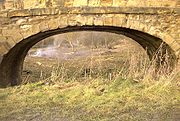
Butterley Tunnel
Butterley Tunnel is a one and three quarter mile long canal tunnel on the Cromford Canal below Ripley, in Derbyshire, England, opened to traffic in 1794.-Origins:...
was excavated by first sinking 33 shafts, about 75 yards (68.6 m) apart as much as 57 yards (52.1 m) deep to give a number of working faces. Most of the heading was through soil, with some coal measures and iron ore deposits, the final tunnel being lined through most of its length.
By 1793 the company had a balance in hand of only £273 and the cost had risen to half as much again as Jessop's original estimate. Nevertheless the canal was showing an income, unfinished though it was.
In August, however, there were problems with the Derwent Aqueduct which required considerable modification. The spandrel walls had parted due to the horizontal forces imposed by the canal, and a longitudinal split had opened up in the arch. In his report to the canal committee, Jessop gave his opinion that the use of Crich lime, being unusually pure, had delayed the setting of the mortar. Later writers, with the benefit of engineering knowledge acquired after Jessop's time, have suggested that the spandrel walls were simply too slender for the forces imposed. At any rate, the arch was partly dismantled and steel tie bars and lateral reinforcing arches were installed, together with external buttresses. This Jessop did at his own expense.
In the end, despite costing about twice the initial estimate (£42,697) (£ as of ),, the canal opened in 1794 and was a financial success.
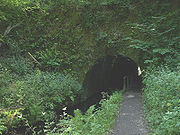
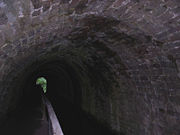
Operation
Jessop had based his initial predictions for the expected returns on the carriage of limestone from Cromford and CrichCrich
Crich is a village in Derbyshire in England. It has the National Tramway Museum inside the Crich Tramway Village, and at the summit of Crich Hill above, a Memorial Tower for those of the Sherwood Foresters regiment who died in battle, particularly in World War I.Built in 1923 on the site of an...
and coal from Pinxton. However the canal itself encouraged new enterprises.
The canal mostly carried coal
Coal
Coal is a combustible black or brownish-black sedimentary rock usually occurring in rock strata in layers or veins called coal beds or coal seams. The harder forms, such as anthracite coal, can be regarded as metamorphic rock because of later exposure to elevated temperature and pressure...
, lead
Lead
Lead is a main-group element in the carbon group with the symbol Pb and atomic number 82. Lead is a soft, malleable poor metal. It is also counted as one of the heavy metals. Metallic lead has a bluish-white color after being freshly cut, but it soon tarnishes to a dull grayish color when exposed...
and iron
Iron
Iron is a chemical element with the symbol Fe and atomic number 26. It is a metal in the first transition series. It is the most common element forming the planet Earth as a whole, forming much of Earth's outer and inner core. It is the fourth most common element in the Earth's crust...
ore, some extracted from inside the Butterley Tunnel
Butterley Tunnel
Butterley Tunnel is a one and three quarter mile long canal tunnel on the Cromford Canal below Ripley, in Derbyshire, England, opened to traffic in 1794.-Origins:...
. Copper
Copper
Copper is a chemical element with the symbol Cu and atomic number 29. It is a ductile metal with very high thermal and electrical conductivity. Pure copper is soft and malleable; an exposed surface has a reddish-orange tarnish...
was brought from as far away as Ecton
Ecton
Ecton is a village and civil parish in the Borough of Wellingborough in Northamptonshire, England. The village is just east of Northampton, just off the A4500 road. It was one of the first villages in Northamptonshire to be given conservation status...
Hill in Staffordshire and the canal opening the way for lead
Lead
Lead is a main-group element in the carbon group with the symbol Pb and atomic number 82. Lead is a soft, malleable poor metal. It is also counted as one of the heavy metals. Metallic lead has a bluish-white color after being freshly cut, but it soon tarnishes to a dull grayish color when exposed...
from Ecton, as well as Wirksworth
Wirksworth
Wirksworth is a small market town in Derbyshire, England, with a population of over 9,000.The population of the Wirksworth area including Cromford, Bolehill and Middleton-by-Wirksworth is about 12,000. Wirksworth is listed in the Domesday Book in 1086. Within it is the source of the River...
to be taken to the Lead Market at Hull
Kingston upon Hull
Kingston upon Hull , usually referred to as Hull, is a city and unitary authority area in the ceremonial county of the East Riding of Yorkshire, England. It stands on the River Hull at its junction with the Humber estuary, 25 miles inland from the North Sea. Hull has a resident population of...
and chert
Chert
Chert is a fine-grained silica-rich microcrystalline, cryptocrystalline or microfibrous sedimentary rock that may contain small fossils. It varies greatly in color , but most often manifests as gray, brown, grayish brown and light green to rusty red; its color is an expression of trace elements...
from Bakewell
Bakewell
Bakewell is a small market town in the Derbyshire Dales district of Derbyshire, England, deriving its name from 'Beadeca's Well'. It is the only town included in the Peak District National Park, and is well known for the local confection Bakewell Pudding...
to the Potteries
Stoke-upon-Trent
Stoke-upon-Trent, commonly called Stoke or Stoke town, is a component town of the city of Stoke-on-Trent, in the ceremonial county of Staffordshire, England....
. It also allowed the finished products of the area to be exported widely, the Butterley Company
Butterley Company
Butterley Engineering was an engineering company based in Ripley, Derbyshire. The company was formed from the Butterley Company which began as Benjamin Outram and Company in 1790 and existed until 2009.-Origins:...
's castings and Arkwright's spun cotton
Cotton
Cotton is a soft, fluffy staple fiber that grows in a boll, or protective capsule, around the seeds of cotton plants of the genus Gossypium. The fiber is almost pure cellulose. The botanical purpose of cotton fiber is to aid in seed dispersal....
. The opening of the Derby Canal
Derby Canal
The Derby Canal ran from the Trent and Mersey Canal at Swarkestone to Derby and Little Eaton, and to the Erewash Canal at Sandiacre, Derbyshire, England. The canal gained its Act of Parliament in 1793 and was fully completed in 1796...
and the Nottingham Canal
Nottingham Canal
The Nottingham Canal was a long canal between Langley Mill in Derbyshire and Nottingham, England. It opened in 1796, and most of it was closed in 1937. The southern section is now part of the River Trent Navigation, and the northern section is a nature reserve.-Origins:The idea for the canal first...
, both in 1796 , further facilitated the latter's trade with these textile
Textile
A textile or cloth is a flexible woven material consisting of a network of natural or artificial fibres often referred to as thread or yarn. Yarn is produced by spinning raw fibres of wool, flax, cotton, or other material to produce long strands...
centres.
Although Arkwright had suggested that water should be drawn from the Derwent (by raising his weir at Masson Mill and feeding it via an aqueduct to Cromford Meadows - thus improving his plans for quarries behind Willersley and adding extra power to his mill wheels at the expense of the Canal Company), the canal committee had secretly no intention of so doing. The Proprietors changed the line of the canal to its present terminus, where a connection was made to the Cromford sough
Sough
A sough is an underground channel for draining water out of a mine. Its ability to drain a mine depends on the bottom of the mine being higher than a neighbouring valley...
, even though they had to purchase the land from Arkwright at £1000 and landscape (at unknown cost) the grounds of his then house. Water could be drawn from the sough at night as well as at weekends. Coming from underground, it was slightly warm, and it was said that it never froze. (Arkwright had been using the sough water to power Cromford Mill
Cromford Mill
Cromford Mill was the first water-powered cotton spinning mill developed by Richard Arkwright in 1771 in Cromford, Derbyshire, England, which laid the foundation of his fortune and was quickly copied by mills in Lancashire, Germany and the United States...
since the last century.) The opening of the Nottingham Canal provided further water via the Butterley Reservoir, almost above Butterley Tunnel and on the summit level of the Cromford Canal.
The sign illustrated (left) was displayed at both ends of the Butterley tunnel, and stressed the importance of only using the narrow tunnel in any one direction at particular times. There are reported instances of fines levied for non-compliance with these rules.
In 1819 the Mansfield and Pinxton Railway
Mansfield and Pinxton Railway
The Mansfield and Pinxton Railway was an early horse-drawn railway company in the United Kingdom, constructed in 1819 to transport coal between Mansfield and the head of the Pinxton branch of the Cromford Canal and thence by the Erewash Valley and the Trent to Leicester...
opened up trade with Mansfield
Mansfield
Mansfield is a town in Nottinghamshire, England. It is the main town in the Mansfield local government district. Mansfield is a part of the Mansfield Urban Area....
including moulding sand for the foundries.
In 1831, the Cromford and High Peak Railway
Cromford and High Peak Railway
The Cromford and High Peak Railway in Derbyshire, England, was completed in 1831, to carry minerals and goods between the Cromford Canal wharf at High Peak Junction and the Peak Forest Canal at Whaley Bridge -Origins:...
opened a route up to Manchester
Manchester
Manchester is a city and metropolitan borough in Greater Manchester, England. According to the Office for National Statistics, the 2010 mid-year population estimate for Manchester was 498,800. Manchester lies within one of the UK's largest metropolitan areas, the metropolitan county of Greater...
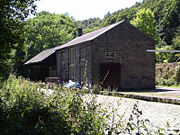
Limestone
Limestone is a sedimentary rock composed largely of the minerals calcite and aragonite, which are different crystal forms of calcium carbonate . Many limestones are composed from skeletal fragments of marine organisms such as coral or foraminifera....
from the Butterley Company
Butterley Company
Butterley Engineering was an engineering company based in Ripley, Derbyshire. The company was formed from the Butterley Company which began as Benjamin Outram and Company in 1790 and existed until 2009.-Origins:...
's quarry at Crich
Crich
Crich is a village in Derbyshire in England. It has the National Tramway Museum inside the Crich Tramway Village, and at the summit of Crich Hill above, a Memorial Tower for those of the Sherwood Foresters regiment who died in battle, particularly in World War I.Built in 1923 on the site of an...
with a plateway
Plateway
A plateway is an early kind of railway or tramway or wagonway, with a cast iron rail. They were mainly used for about 50 years up to 1830, though some continued later....
to the Amber Wharf at Bullbridge. In an attempt to avoid using cable-haulage
Cable railway
A cable railway is a steeply graded railway that uses a cable or rope to haul trains.-Introduction:...
or a rack and pinion
Rack railway
A rack-and-pinion railway is a railway with a toothed rack rail, usually between the running rails. The trains are fitted with one or more cog wheels or pinions that mesh with this rack rail...
system, a remarkable steam engine, the "Steam Horse"
Steam Horse locomotive
The Steam Horse was constructed by the Butterley Company in Derbyshire in 1813 by William Brunton . Also known as the "Mechanical Traveller" it had a pair of mechanical legs, with feet that gripped the rails at the rear of the engine to push it forwards at about three miles an hour.-Design:To...
was tried out in 1813.
In 1840 when the North Midland Railway
North Midland Railway
The North Midland Railway was a British railway company, which opened its line from Derby to Rotherham and Leeds in 1840.At Derby it connected with the Birmingham and Derby Junction Railway and the Midland Counties Railway at what became known as the Tri Junct Station...
was built, George Stephenson
George Stephenson
George Stephenson was an English civil engineer and mechanical engineer who built the first public railway line in the world to use steam locomotives...
was faced with the problem at Bullbridge of taking the line over the road but under the canal, thus the Bullbridge Aqueduct
Bullbridge Aqueduct
The Bull Bridge Aqueduct was situated on the Cromford Canal, built in 1794, at Bullbridge east of Ambergate along the Amber Valley where it turned sharply to cross the valley and the Ambergate to Nottingham road...
, in its final form, placed the river, road, railway and canal at four levels.

Wirksworth
Wirksworth is a small market town in Derbyshire, England, with a population of over 9,000.The population of the Wirksworth area including Cromford, Bolehill and Middleton-by-Wirksworth is about 12,000. Wirksworth is listed in the Domesday Book in 1086. Within it is the source of the River...
had reached such a depth that Meerbrook Sough
Sough
A sough is an underground channel for draining water out of a mine. Its ability to drain a mine depends on the bottom of the mine being higher than a neighbouring valley...
was built, draining into the Derwent near Whatstandwell
Whatstandwell
Whatstandwell is a village on the River Derwent in Derbyshire, England.It is about five miles south of Matlock and about four miles north of Belper...
, which deprived both Arkwrights mill and the canal of water, leaving the latter with only that from Butterley Reservoir. Accordingly the canal owners first hired a pump and then built the Leawood Pump House
Leawood Pump House
The Leawood Pump House was built in 1849 to supply water to the Cromford Canal, built some 50 years previously. It is a Grade II* listed building....
in 1849 buying a Cornish type beam engine
Beam engine
A beam engine is a type of steam engine where a pivoted overhead beam is used to apply the force from a vertical piston to a vertical connecting rod. This configuration, with the engine directly driving a pump, was first used by Thomas Newcomen around 1705 to remove water from mines in Cornwall...
from Grahams of Elscar.
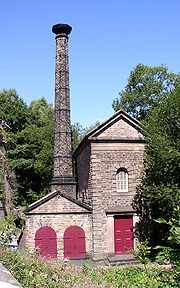
Decline
In 1802 the canal had carried over 150,000 tons and by 1842 nearly 300,000, then in 1849, the Manchester, Buxton, Matlock and Midlands Junction RailwayManchester, Buxton, Matlock and Midlands Junction Railway
The Manchester, Buxton, Matlock and Midland Junction Railway ran from a junction with the Midland Railway at Ambergate to Rowsley north of Matlock and thence to Buxton....
was built alongside as far as Ambergate, which reached Manchester
Manchester
Manchester is a city and metropolitan borough in Greater Manchester, England. According to the Office for National Statistics, the 2010 mid-year population estimate for Manchester was 498,800. Manchester lies within one of the UK's largest metropolitan areas, the metropolitan county of Greater...
in 1867. A further line to Pye Bridge was built in 1875. By 1888 trade had shrunk to 45,000 tons a year.
In 1846, Parliamentary assent was granted to merge with the MBM&MJR. The sale was not carried through until 1852 by which time the Midland Railway
Midland Railway
The Midland Railway was a railway company in the United Kingdom from 1844 to 1922, when it became part of the London, Midland and Scottish Railway....
and the LNWR
London and North Western Railway
The London and North Western Railway was a British railway company between 1846 and 1922. It was created by the merger of three companies – the Grand Junction Railway, the London and Birmingham Railway and the Manchester and Birmingham Railway...
had assumed joint control and, with railway lines from Rowsley
Rowsley
Rowsley is a village on the A6 road in the English county of Derbyshire.It is at the point where the River Wye flows into the River Derwent and prospered from mills on both.-Overview:...
through Ambergate to the north and south, it was being used for little more than local traffic.
In 1889, subsidence closed the 3,063 yard (2801m) Butterley Tunnel
Butterley Tunnel
Butterley Tunnel is a one and three quarter mile long canal tunnel on the Cromford Canal below Ripley, in Derbyshire, England, opened to traffic in 1794.-Origins:...
for four years, and further subsidence in 1900 closed the Tunnel permanently. Most of the canal was abandoned in 1944 with the exception of a half-mile (800m) stretch to Langley Mill which was abandoned in 1962. The Bullbridge Aqueduct was removed in 1968 when the Ripley road was widened. In 1985 the Codnor Park Reservoir was lowered by 6 feet (1.8 m) and a lock was removed as part of a flood prevention scheme.
Restoration
After closure, the canal was taken over by the British Waterways Board and acquired by Derbyshire County Council in 1974. Between 1968-9 and 1989 the 5 miles between Cromford and Ambergate were restored either partly or wholly by the Cromford Canal Society [CCS] together with the beam engine (the Leawood Pump) which was restored to full operation, pumping water from the River Derwent to the Canal above. CCS ran horse-drawn passenger boats (up to 15,000 passengers a year) on the 1½ mile section from Cromford to Leawood and steamed the beam engine on regular occasions. The lower section from Leawood to Leashaw (through Gregory Tunnel) was restored to navigation but storm damage to embankments prevented its use. CCS ceased to exist in 1990 and this part of the canal has nearly reverted to pre-restoration condition.Attempts are being made to restore the canal and about 5 miles (8 km) of it remains in water.
The towpath from Ambergate to Cromford is now a very popular walking route, with the Derwent Valley Line
Derwent Valley Line
The Derwent Valley Line is a railway line from Derby to Matlock in Derbyshire.The line follows the Midland Main Line as far as Ambergate Junction, which is just south of Ambergate railway station, continuing to Matlock, following the course of the River Derwent.*Derby*Duffield**Former branch line...
adjacent, Leawood Pump House
Leawood Pump House
The Leawood Pump House was built in 1849 to supply water to the Cromford Canal, built some 50 years previously. It is a Grade II* listed building....
and the High Peak Junction
High Peak Junction
High Peak Junction, near Cromford, Derbyshire, England, is the name now used to describe the site where the former Cromford and High Peak Railway , whose workshops were located here, meets the Cromford Canal...
of the Cromford and High Peak Railway
Cromford and High Peak Railway
The Cromford and High Peak Railway in Derbyshire, England, was completed in 1831, to carry minerals and goods between the Cromford Canal wharf at High Peak Junction and the Peak Forest Canal at Whaley Bridge -Origins:...
.
Friends of the Cromford Canal
The Friends of the Cromford Canal is a charitable organisation whose aim is to see the restoration of the Cromford Canal for the benefit of the general public. The society promotes the restoration of the Canal to navigation, and to connect it to the national inland waterway system at the junction with the Erewash Canal at Langley Mill.See also
- Canals of Great Britain
- History of the British canal systemHistory of the British canal systemThe British canal system of water transport played a vital role in the United Kingdom's Industrial Revolution at a time when roads were only just emerging from the medieval mud and long trains of pack horses were the only means of "mass" transit by road of raw materials and finished products The...
- Cromford and High Peak RailwayCromford and High Peak RailwayThe Cromford and High Peak Railway in Derbyshire, England, was completed in 1831, to carry minerals and goods between the Cromford Canal wharf at High Peak Junction and the Peak Forest Canal at Whaley Bridge -Origins:...

